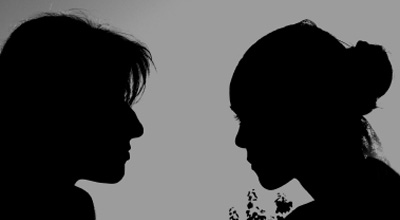Several women friends asked me about bisexuality as a trend on campus. Asking around, I got divergent responses, but one young woman (who was dealing with her own sexuality) filled me in on how the perceptions surrounding bi-sexuality may have changed along with the vocabulary. Here’s her take …
Coming from small town Texas, but attending Vassar College and living in San Francisco, Paris, and New York, I’ve seen a range of sexual repression and openness in my 23 years. The words “fag”, “dyke”, and “queer” were all used as pejorative and derogatory insults tossed around on the back of the school bus or during a heated game of tetherball. Flash forward to my first week at college, during a game show/panel discussion hosted by the Queer Coalition, as I listened to one panelist describe why it was that she chose to identify as a “dyke,” as opposed to gay or lesbian. She explained how empowering it was for her (and many other women) to re-appropriate a word once used as a hateful and provocative slur and embrace it as a positive identifier.
Girls used to make out with each other at high school parties and in college dorm rooms to no real end except, perhaps, titillation for the male attendees. It was at Vassar that I first heard the term “LUG” (Lesbian Until Graduation), which succinctly embodies the phenomenon of experimentation mixed with “lack of commitment” to that lifestyle. Why has same-sex involvement become such a nonchalant and under the radar occurrence?
Human nature constantly urges us to label – to categorize each thing so we can put it away and not think about it any longer. Sexuality is just one of the many phenomena we like to understand in black or white. Homosexuality has long been seen as unnatural or mysterious and thus, we must pit it against our understanding of heterosexuality. If there is a gray area, it’s lost on us. So let’s address that gray area – that indefinable space between gay and straight – where the entire spectrum of sexuality resides.
A bit about my personal experience: At age 20 I found myself in my first same-sex romantic situation, which seemed to come out of nowhere. In retrospect, there were always signs that indicated an attraction to women that I either repressed or chose to ignore as simply pubescent questioning. However, three years later and a lot of self-inquiry under my belt, I’m no closer to figuring out whether I’m gay or straight. It’s probably because I’m neither.
While struggling to understand my sexuality – and the struggle isn’t over yet – I found a book that was incredibly helpful, even if a little clichéd at times. It’s called Look Both Ways: Bisexual Politics, by Jennifer Baumgardner. She focuses on the plight of the 21st century bisexual female by weaving together her own personal narrative with historical, literary and theoretical (or lack thereof) representations of bisexuals. She addresses the hate and misunderstanding that the word “bisexual” provokes – a term that is associated with indecision, purgatory, “passing” or safety and promiscuity.
Straight and gay populations discriminate against bisexuals because they aren’t sure which way the person in question will decide to go, or they feel that identifying as bisexual is really just a premature way of saying “I’m gay”, or a lie made-up to turn people on by their own sexual “openness.” Bisexuals often pass as straight but reap the benefits of the gay world, i.e. finding same-sex relationships without having to deal with the homophobic attitudes that come along with looking a certain way. And they get a lot of flack for that.
Even though bisexuality seems like a less limiting term than either gay or straight, it clearly has its limitations and its stigmas. And we’ve still left so much of that gray area uncovered – most of which is addressed with the idea of and the word “queer.” Wikipedia defines it as “a sexual orientation and/or gender identity or gender expression that does not conform to heteronormative society,” or more simply, “a contemporary antonym of heteronormative.” To be queer is to identify as a non-heterosexual – someone who isn’t strictly interested in, attracted to, and romantically inclined towards members of the opposite sex. Or, “gender queer” can mean someone who identifies with a gender that is either in opposition with its generally assumed sex (i.e. penis = male, vagina = female) or somehow transcends the confines we have placed on gender and sex. “Queer” allows the freedom and fluidity of sexuality to remain as such, much better than trying to box it into concrete a term that ends up stifling the contents.
With this understanding, it’s difficult for the young to engage in a dialogue with older generations when the vocabulary is so divided. Gay vs. straight: It’s a thing of the past to believe that these are your only two options. Some find it exceedingly difficult, myself included, to explain queer sexuality to others and consequently to ourselves when contemporary culture is so focused on either/or. It shouldn’t be necessary to justify or explain who you are attracted to and why, but living in today’s society requires that you must give people something to work with. Therefore, “queer” is a term that people must begin to understand as it encapsulates so many different ways of defining individual sexuality.
My generation is attempting to break down the barriers of gay/straight, male/female, one/the other. Perhaps this is why young women feel able to experiment without labeling themselves – without taking on the guilt and shame that come along with perceived sexual deviancy. Alternatively, these are the reasons why people in my generation are reclaiming former slurs. They are turning them into empowering and boastful descriptors that more accurately portray the fluidity of sexuality.
Refusing to define oneself in historically black and white terms is becoming more and more common, and the term “queer” has been reclaimed in order to define the indefinable.

